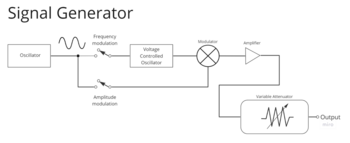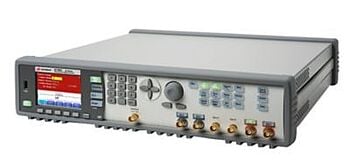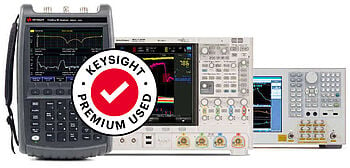Signal Generator Guide: What Is It and How To Use It Properly
Log In to Your Account
Enter your username and password here in order to log in on the website
Forgot your password?Account Benefits
Get a customised view of the Used Equipment Store
Manage your details to get quick responses by the team
Stay up-to-date on specials, prices and availability
Create Your Account
Article Feedback
Are you tired of wrestling with unreliable signal generators that fail to meet your expectations? You're not alone. Many engineers face the frustrating challenge of finding a signal generator that delivers accurate results while still being easy to use.
But what if we told you there's a way to overcome these obstacles and master the art of signal generation?
This guide will unveil the secrets behind selecting the perfect signal generator, setting it up correctly, and using it effectively to ensure precise and dependable measurements every time.
Say goodbye to guesswork and hello to confidence as we take you on a journey through the world of signal generators. Keep reading to unlock your full potential as an engineer and make your projects shine.
A signal generator is an electronic device that generates repeating or non-repeating waveforms used to test and evaluate electronic test equipment. It simulates real-world signals and conditions, enabling you to test the performance and behavior of electronic systems.
They come in a variety of shapes and sizes, from handheld devices with basic waveforms to sophisticated benchtop models capable of generating complex signals over a wide frequency range.
Signal generators are essential for testing circuits, verifying designs, troubleshooting equipment, characterizing components, and more.
A signal generator has several key components, including an oscillator, modulator, amplifier, and output stage. The signal generation process starts with the oscillator, whichgenerates a stable and repetitive waveform, such as a sine wave.

The waveform passes through the modulator, which shapes the waveform into the desired signal type, such as a square wave or triangle wave. It adds any modulation, such as amplitude, frequency, or phase modulation. It then amplifies the output signal to the desired level and sends it to the DUT (device under test).
A signal generator can generate various waveforms, including sine, square, triangle, sawtooth, and arbitrary. Sine wave signals are commonly used for testing and evaluating audio systems, while square and triangle signals test digital circuits. Sawtooth and arbitrary signals test various electronic systems, as they can simulate real-world signals and conditions.





Explore our certified used equipment, with up to 5 years warranty and an additional 15% discount exclusively for educators and researchers.































In order to use this feature, you need to enable notifications.
Manage notification preferences
Signal generators come in various forms with unique features, advantages, and limitations. Understanding these differences can help you choose the right signal generator for your specific needs.
A function generator is a versatile type of signal generator that produces standard waveforms such as sine, square, triangle, and sawtooth waves. It allows you to adjust various parameters, including amplitude, frequency, and duty cycle, to meet specific testing requirements.
Function generators offer several advantages, such as
These features make them suitable for various applications, including testing filters, amplifiers, and oscillators and characterizing the frequency response of circuits.
Function generators also have some limitations. They may not offer the highest precision or the ability to generate complex, user-defined waveforms. Additionally, they might not support advanced modulation schemes, limiting their usefulness in certain applications.
Used function generators are an affordable option if you want to save on costs while getting reliable test results. Used and premium used models from reputable manufacturers like Keysight can deliver excellent performance and quality at a fraction of the price of new equipment, making them an attractive choice for budget-conscious engineers!

Arbitrary waveform generators (AWGs) are advanced signal generators that allow you to create and output complex, user-defined waveforms with high precision and accuracy.
These devices offer greater flexibility compared to traditional function generators, enabling the generation of arbitrary waveforms, including those with intricate shapes, varying amplitudes, and irregular timing.
The advantages of using AWGs include
Typical uses for AWGs involve simulating real-world electronic signals, such as those found in communication systems, sensors, and control systems. They are also valuable in applications requiring the generation of non-standard or mathematically defined waveforms.
However, AWGs have limitations, such as a generally higher cost than function generators and a potentially narrower frequency range. Additionally, they may have a steeper learning curve due to their advanced features and software requirements.
High-end AWGs from many manufacturers can be expensive and have long wait times for shipping. However, used and premium used models from Keysight offer a more budget-friendly alternative with fast shipping, and you don't sacrifice quality or performance in the process.

Pulse generators are specialized signal generators designed to produce precisely timed, repeating pulses with adjustable parameters such as pulse width, repetition rate, and amplitude. These devices are essential for applications requiring the generation of digital signals, trigger signals, or precise timing events.
The advantages of using pulse generators include their ability to produce clean, sharp-edged pulses with high timing accuracy and the flexibility to adjust key pulse parameters to meet specific requirements. Pulse generators are commonly used to test and characterize digital circuits, clock and timing systems, and components such as counters, shift registers, and flip-flops.
Pulse generators also have limitations, including a restricted frequency range compared to other signal generator types and the inability to produce analog or complex waveforms. They may also be less versatile in terms of modulation capabilities.
Since pulse generators are used in more specialized applications, they can be costly when looking to purchase. Used and premium used Keysight pulse generators offer an excellent solution for those looking to save on costs.
Used models are often significantly cheaper than their brand-new counterparts. Some used pulse generators offer up to 60% off, a significant advantage for anyone with limited funds.

A radio frequency (RF) generator generates high-frequency signals in the radio frequency spectrum, typically ranging from a few kilohertz to several gigahertz. These generators are crucial for various applications in wireless communication systems, RF component testing, and electromagnetic compatibility (EMC) testing.
The advantages of using RF signal generators include
RF signal generators are typically used in testing and characterizing RF components such as filters, amplifiers, and antennas, as well as simulating wireless signals for receiver testing and system calibration.
RF signal generators also come with some limitations, including a potentially narrower frequency range compared to other types of signal generators, the need for external modulation sources for some models, and variations in output power capabilities. They may also be more expensive than other types of signal generators due to their specialized functions.
Buying a used RF signal generator through Keysight helps you save on costs, and since they come with a warranty, you get the peace of mind that you are getting a quality product.

Vector signal generators (VSGs) are advanced signal generators capable of producing complex modulated signals used in modern wireless communication standards, such as 5G, 4G LTE, and Wi-Fi.
These devices generate signals that can closely emulate real-world communication system conditions, making them essential for designing, testing, and validating modern wireless devices and systems.
The advantages of using VSGs include
A vector signal generator is used in testing and validating wireless devices, such as smartphones, base stations, and IoT devices, as well as evaluating the performance of communication systems under various conditions. They are also used to develop adaptive radio frequency (RF) systems and cognitive radio applications.
VSGs come with some limitations, including potentially higher costs than other types of signal generators, wider bandwidths for higher-end models, and more complex user interfaces compared to other types of signal generators.






Don’t miss special offers, news and announcements on the latest used equipment. Unsubscribe any time.































In order to use this feature, you need to enable notifications.
Manage notification preferences
Signal generators are versatile tools with various essential features that engineers can use to produce different signals. Understanding these features can help you make the most of your signal generator and ensure accurate application results. Here, we'll discuss the key features, including frequency range, waveform type, amplitude, and modulation.
By understanding and properly utilizing these key features, you can generate signals that accurately represent the conditions you need to simulate, ensuring reliable and precise results in your testing and development processes
Setting up a signal generator is crucial for obtaining accurate and reliable measurements in your testing and development processes. A well-configured signal generator ensures that the generated signals meet the desired parameters and specifications, allowing you to effectively simulate the required conditions for your project.
This section will cover the essential steps and considerations for setting up your signal generator, helping you achieve the best results in your testing and development activities.
Selecting the right signal generator is important for achieving accurate and reliable test results. Plus, they are a considerable investment, so it pays to choose carefully. To make the best decision, consider the following factors while considering your specific project requirements.
To prioritize features based on your project requirements, identify the most critical aspects of your testing needs, and focus on the signal generator specifications that directly impact those aspects. This tip will help you balance the cost and performance of the equipment.
When comparing different models and brands of signal generators, consider cost, performance, and reliability. Evaluate each option based on its ability to meet your project requirements while staying within your budget. Read reviews, consult peers, or get advice from experts to gather insights into the performance and reliability of various models.
You will need to choose the right accessories to maximize the performance and get the most out of your signal generator. Here's a list of essential accessories to use with your signal generator.
Each of these accessories is vital to your signal generator setup's overall functionality and effectiveness. Investing in the right accessories ensures accurate, reliable, and efficient testing and measurement processes!
When working with electronic equipment like signal generators, following general safety precautions to protect the equipment and yourself is best. Here are some key safety measures to keep in mind.
By closely following these safety precautions, you will create a safer work environment while minimizing the risk of damage to your signal generator and other equipment. Always prioritize safety when working with electronic devices to ensure accurate and reliable results without putting yourself at risk.
Effectively using your signal generator is a primary way to make sure you get accurate test results. A thorough understanding of the device's capabilities, features, and limitations is vital to maximizing its potential in your projects.
By learning how to operate your signal generator and configure its various settings, you will ensure that it works as intended and produces accurate results.
Operating a signal generator involves several fundamental steps, which we will outline below. Following these simple instructions, you can easily set up your signal generator and generate the desired signals for your specific applications.
Familiarizing yourself with these fundamental steps will help you take full advantage of your signal generator's capabilities and ensure accurate and reliable project results.
Signal generators also have more advanced features, allowing greater precision in testing and measurement applications. Here's a brief overview of some key advanced features and how to access and use them.
Everything we have spoken about so far is more than just theory. Signal generators play an important role in real-world engineering applications, enabling engineers to perform various tasks such as troubleshooting circuits, simulating sensor signals, and testing filters and amplifiers. Here are some examples of how signal generators are used in these scenarios.
Optimizing signal generator performance and maintaining the equipment is crucial for ensuring the quality of your measurements. The following tips and tricks can help you achieve maximum efficiency, accuracy, and reliability in testing and troubleshooting.
To reduce phase noise and improve output accuracy, follow these practical tips to increase your signal generator's performance.
If you want your signal generator to keep operating as it should, you must maintain it, whether a new or used device. Here are some key steps to keep your equipment in excellent condition.
Remember, regular maintenance is crucial for new and used signal generators, ensuring they perform at their best throughout their lifespan. One way to achieve this is through Keysight Care, a comprehensive support plan designed to help you get the best performance from your Keysight equipment.
To learn more about Keysight Care or to discuss your specific needs, talk to your account manager or call our support team at 1 800 829-4444.





Don’t miss special offers, news and announcements on the latest used equipment. Unsubscribe any time.































In order to use this feature, you need to enable notifications.
Manage notification preferences
Accuracy and precision are paramount in test and measurement applications, as they play a critical role in ensuring the validity and reliability of your results. Using a signal generator with low accuracy or precision can lead to incorrect conclusions, poor design decisions, and even product failures.
That's why investing in a high-quality signal generator that delivers accurate and precise signals is essential.
When evaluating the accuracy and precision of a signal generator, consider the following factors.
Keysight signal generators are designed with these factors in mind, offering exceptional accuracy and precision to help you achieve the best possible test results. Their advanced technology, such as high-performance oscillators, digital modulation techniques, and low-noise amplifiers, enable them to produce highly accurate and precise signals.
Investing in a high-quality signal generator like those offered by Keysight will ensure that your test and measurement applications are as accurate and precise as possible!
Are there any benefits to purchasing used signal generators?
Yes, purchasing used signal generators can save you money without sacrificing quality. As long as the equipment is maintained correctly, used signal generators can provide reliable and accurate results.
What should I look for when buying a used signal generator?
When buying a used signal generator, consider its overall condition, calibration status, and maintenance history. Also, ensure it has the required frequency range, waveform types, and modulation capabilities for your needs.
How do I ensure the quality of a used signal generator?
To ensure the quality of a used signal generator, purchase from a reputable seller, verify its performance and accuracy and check if it has been calibrated recently. Regular maintenance and proper care are essential to maintain the quality of the equipment.
Can I use a signal generator to test speakers?
Yes, signal generators can test speakers by generating audio signals. You can analyze the speakers' responses to various frequencies and determine their performance characteristics.
What is the difference between a signal generator and an oscilloscope?
A signal generator produces electrical signals with various waveform types, frequencies, and amplitudes. An oscilloscope is an instrument used to visualize and analyze electrical signals, allowing you to measure and observe their characteristics.
How do I choose the right cable for my signal generator?
Choose cables with low attenuation, proper impedance matching, and quality connectors compatible with your signal generator and the device under test. High-quality cables are essential for minimizing signal loss and preserving signal integrity.
Can I create my own custom waveforms with a signal generator?
Yes, with an arbitrary waveform generator (AWG), you can create custom waveforms by defining each sample point's shape, amplitude, and duration. This feature is helpful in simulating complex signals in various applications.
What is the difference between a function generator and an arbitrary waveform generator?
A function generator produces standard waveforms, such as sine, square, and triangle waves, with adjustable frequency, amplitude, and other parameters. An arbitrary waveform generator (AWG) can create custom, user-defined waveforms with high precision and accuracy, allowing for more complex signal generation.
As any engineer knows, a signal generator is an essential piece of equipment used to create signals of all shapes and sizes, making it an essential tool for testing and debugging circuits.
At Keysight, we are one of the leading manufacturers of signal generators. Our products are known for their quality and reliability.
Right now, we are offering a special deal on refurbished premium signal generators. This is a great opportunity to get your hands on a top-of-the-line instrument at a very reasonable price. So don't wait – head on over to our Used Equipment page and buy a premium signal generator today!

Signal generators play a crucial role in electronic testing in various industries. From sine and square signals to RF and vector signals, the right signal generator can greatly impact the success of an engineer's project.
Keysight's reliable signal generators offer a variety of features and capabilities, making them some of the best on the market. Whether you need a basic unit for simple tasks or an advanced model for sophisticated applications, our team of experts can help you find the perfect signal generator.
See Keysights Used Equipment to find the widest selection of discounted, high-quality signal generators to fit your needs.

